Introduction
WATCH VIDEO ON POSTERIOR TRIANGLE OF NECK [CLICK HERE]
The triangular area on the side of neck behind the sternocleidomastoid muscle and in front of trapezius muscle is called the Posterior triangle. Its base is downwards and apex is upwards and backwards.
What are the boundaries of Posterior Triangle?
The posterior triangle is bounded:
- Anteriorly by posterior border of sternocleidomastoid muscle.
- Posterioly by the anterior border of trapezius muscle..
- Inferiorly the base is formed by the middle third of the clavicle.
- Superiorly the apex is formed at the meeting point of sternocleidomastoid and trapezius muscles.
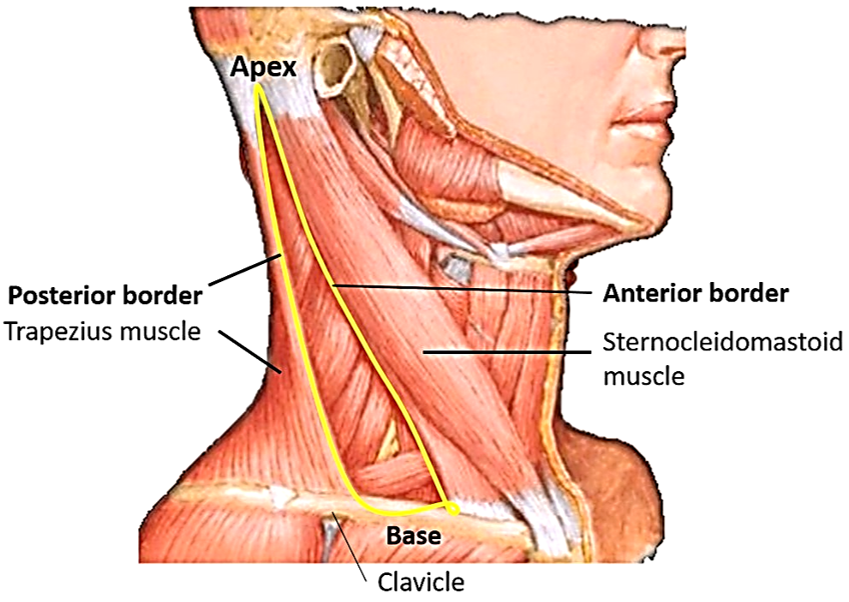
Enumerate the structures present in the roof of Posterior Triangle.
- Skin
- Superficial fascia containing
- Platysma
- Cutaneous nerves
- Lesser occipital nerve (LON)
- Great auricular nerve (GAN)
- Transverse cervical nerve (TCN)
- Supraclavicular nerves (SCN)
- External jugular vein (EJV)
- Investing layer of deep cervical fascia
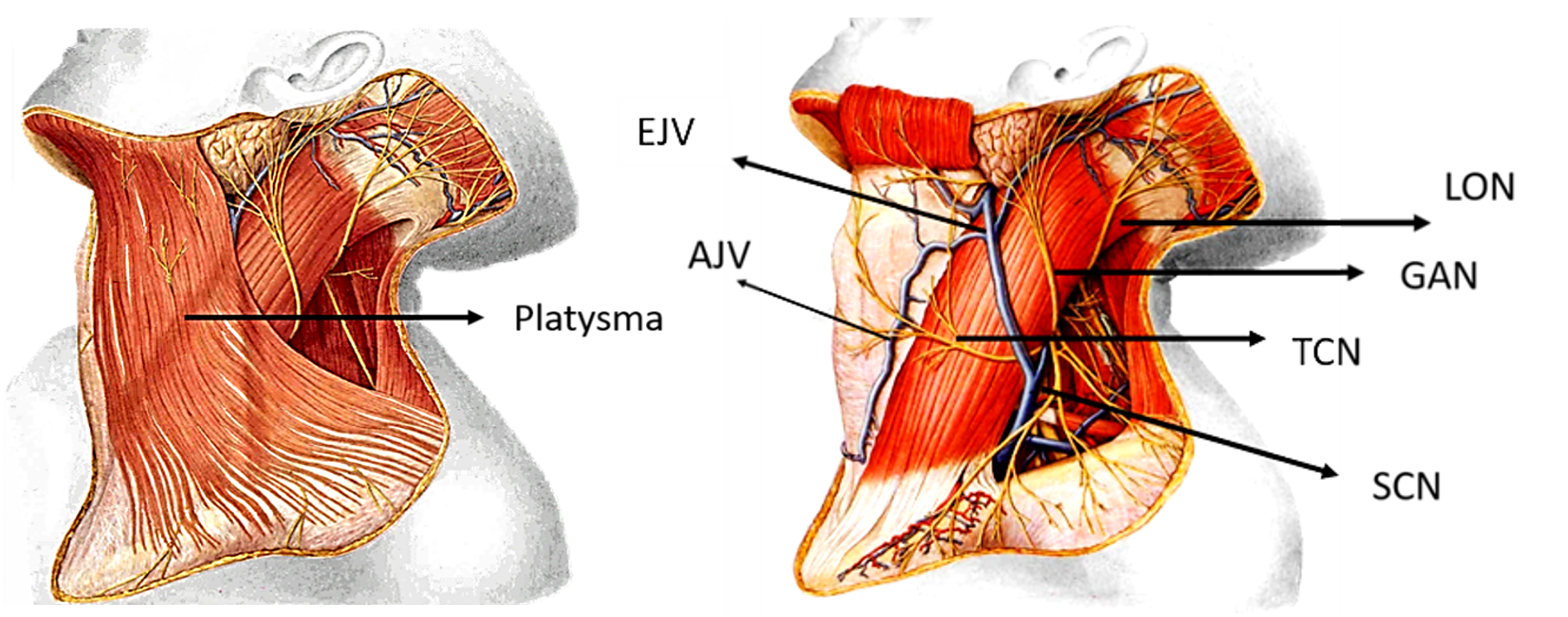
Name the muscles that form the floor of Posterior Triangle.
Floor of the posterior triangle is formed by the prevertebral fascia covering the following muscles from above downwards:
- Semispinalis capitis
- Splenius capitus
- Levator scapulae
- Scalenus medius
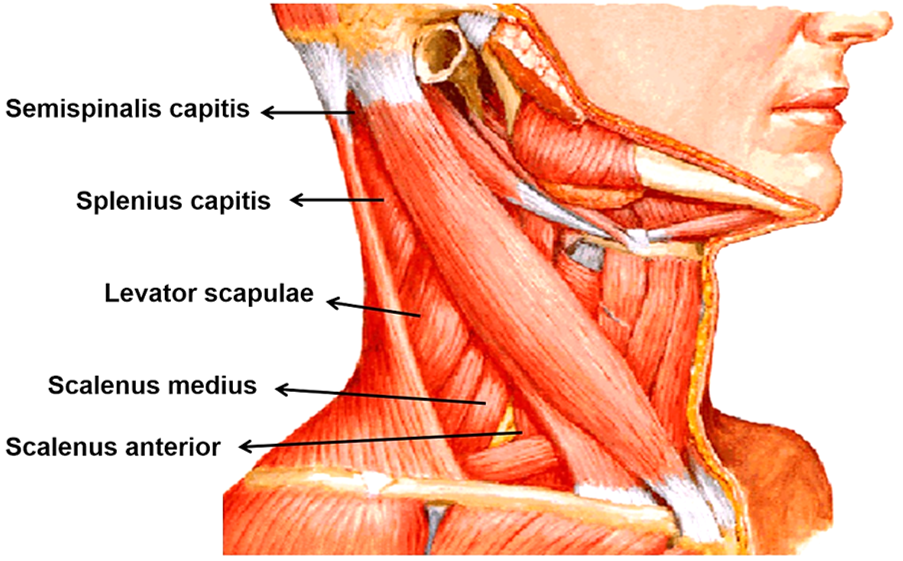
What are the subdivisions of Posterior Triangle?
The posterior triangle is subdivided into two triangles by the inferior belly of the omohyoid:
- a bigger upper part called occipital triangle.
- a smaller lower part termed subclavian (supraclavicular) triangle.
These parts are thus termed since they include occipital and subclavian arteries respectively. 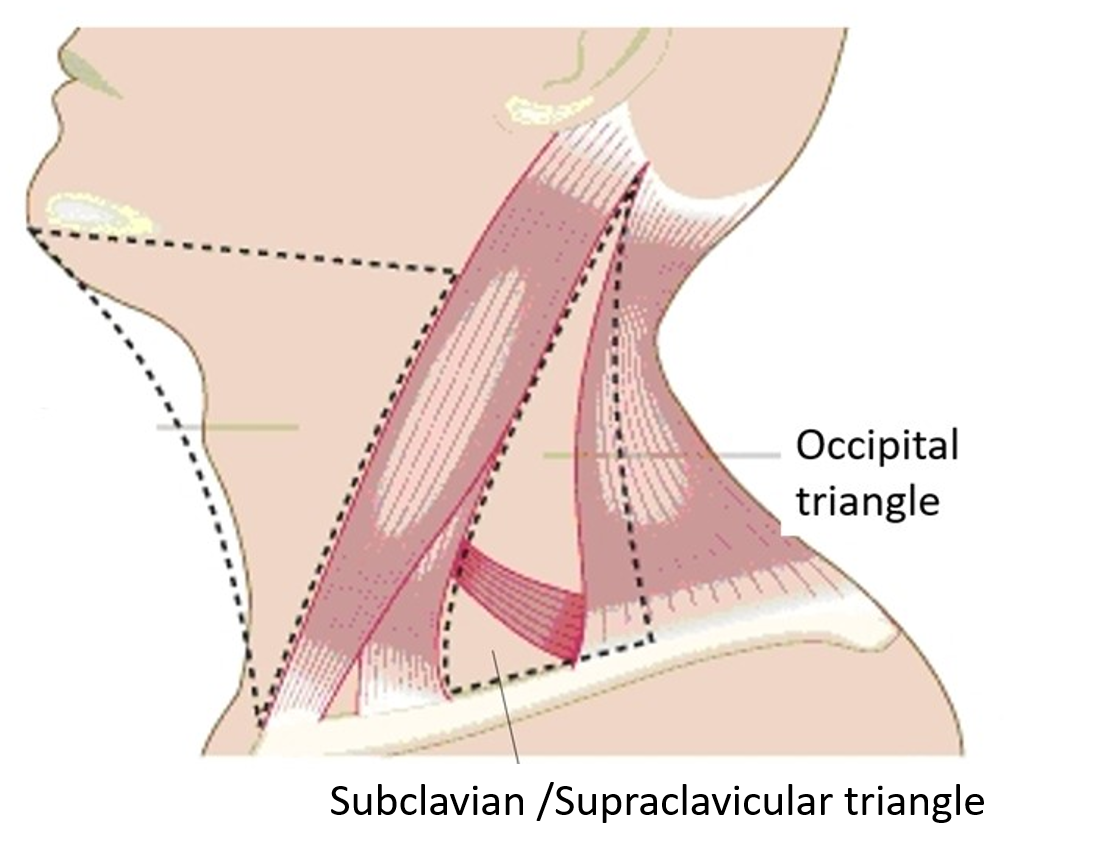
Write in a tabulated form the contents of Occipital and Subclavian/ Supraclavicular Triangles.
| Occipital Tiangle | Subclavian triangle | |
|---|---|---|
| Nerves | Spinal Accessory nerve | Trunks of brachial plexus |
| C3, C4 cervical nerves supplying levator scapulae and trapezius muscles | Long thoracic nerve (C5,6,7) | |
| Dorsal scapular nerve (C5). | Suprascapular nerve ( C5,6) | |
| Begining of 4 cutaneous branches of cervical plexus ( Lesser occipital, great auricular, transverse cervical, supraclavicular) | Nerve to subclavius (C5,6) | |
| Arteries | Occipital artery | Third part of subclavial artery |
| Superficial transverse cervical artery. | Transverse cervical artery | |
| Suprascapular artery | ||
| Lymph nodes | Supra clavicular lymph nodes |
♦ Occipital artery is a branch of external carotid artery.
♦ Transverse cervical and suprascapular arteries are branches of thyrocervical trunk which in turn is a branch of 1st part of subclavian artery.
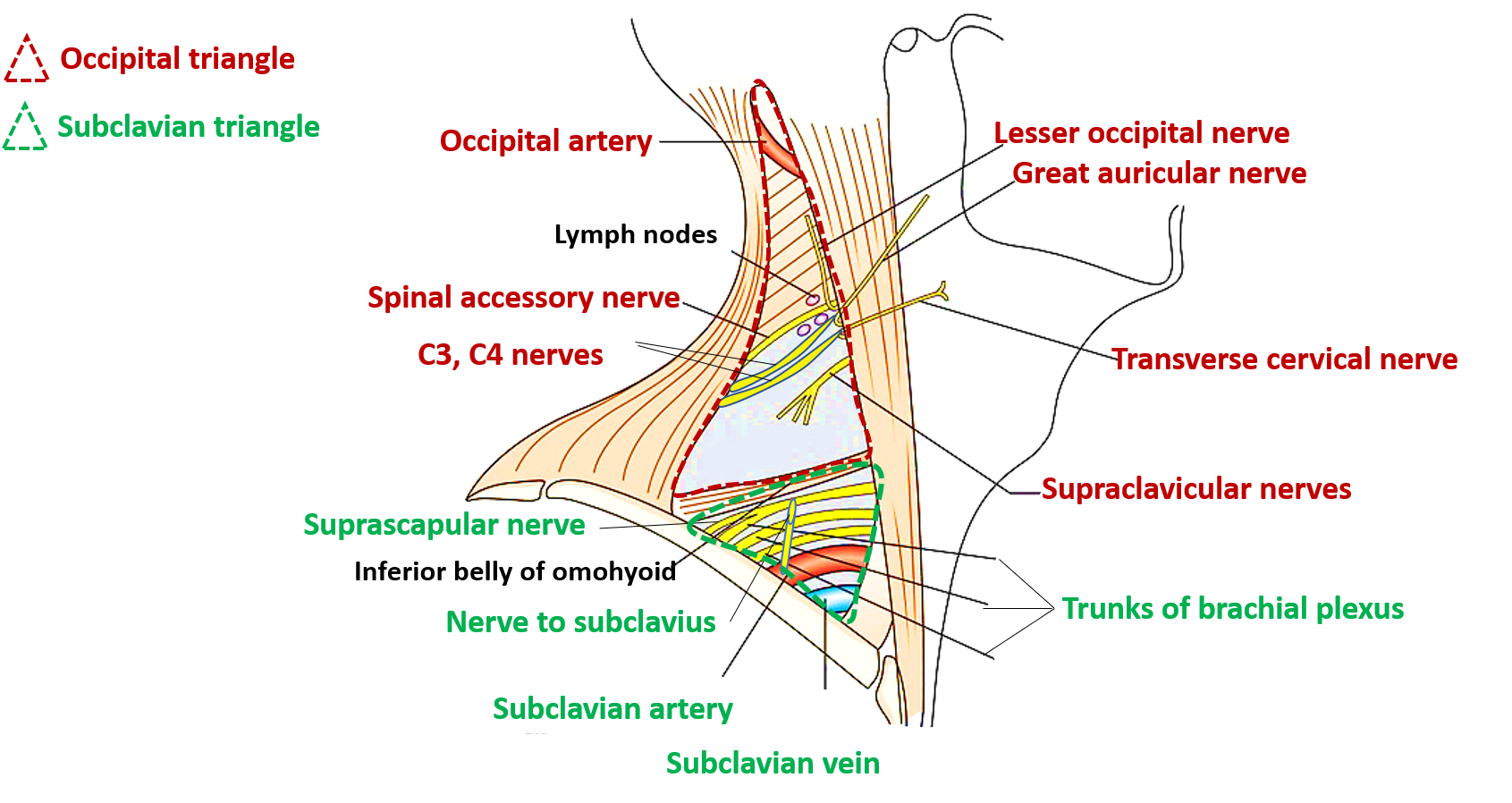
Parts of brachial plexus in the Posterior Triangle.
Brachial plexus supplies upper limb and consists of roots, trunks, divisions and cords. The roots and trunks of brachial plexus and their branches lie in posterior triangle of neck.
- The roots are formed by ventral rami of C5 -T1 spinal nerves.
There are three trunks viz. upper, middle and lower. The upper trunk is formed by the union of C5 and C6 roots, middle trunk is continuation of C7 root and lower trunk is formed by the union of C7 and T1. - Branches from the roots:
- Dorsal scapular nerve originates from C5 root. It pierces the scalenus medius and runs laterally across it to pass deep to levator scapulae which it supplies
- Long thoracic nerve (or nerve to serratus anterior) originates from C5, C6 and C7 roots. It passes downwards behind the brachial plexus and third part of the subclavian artery. It passes deep to the first rib to supply the serratus anterior muscle.
- Branches from the upper trunk
- Nerve to subclavius (C5 and C6) passes downwards in front of the brachial plexus and subclavian vessels to supply the subclavius muscle.
- Suprascapular nerve (C5 and C6) passes laterally deep to inferior belly of omohyoid and trapezius to reach the supraspinous fossa via suprascapular notch supplies supraspinatus and infraspinatus muscles.
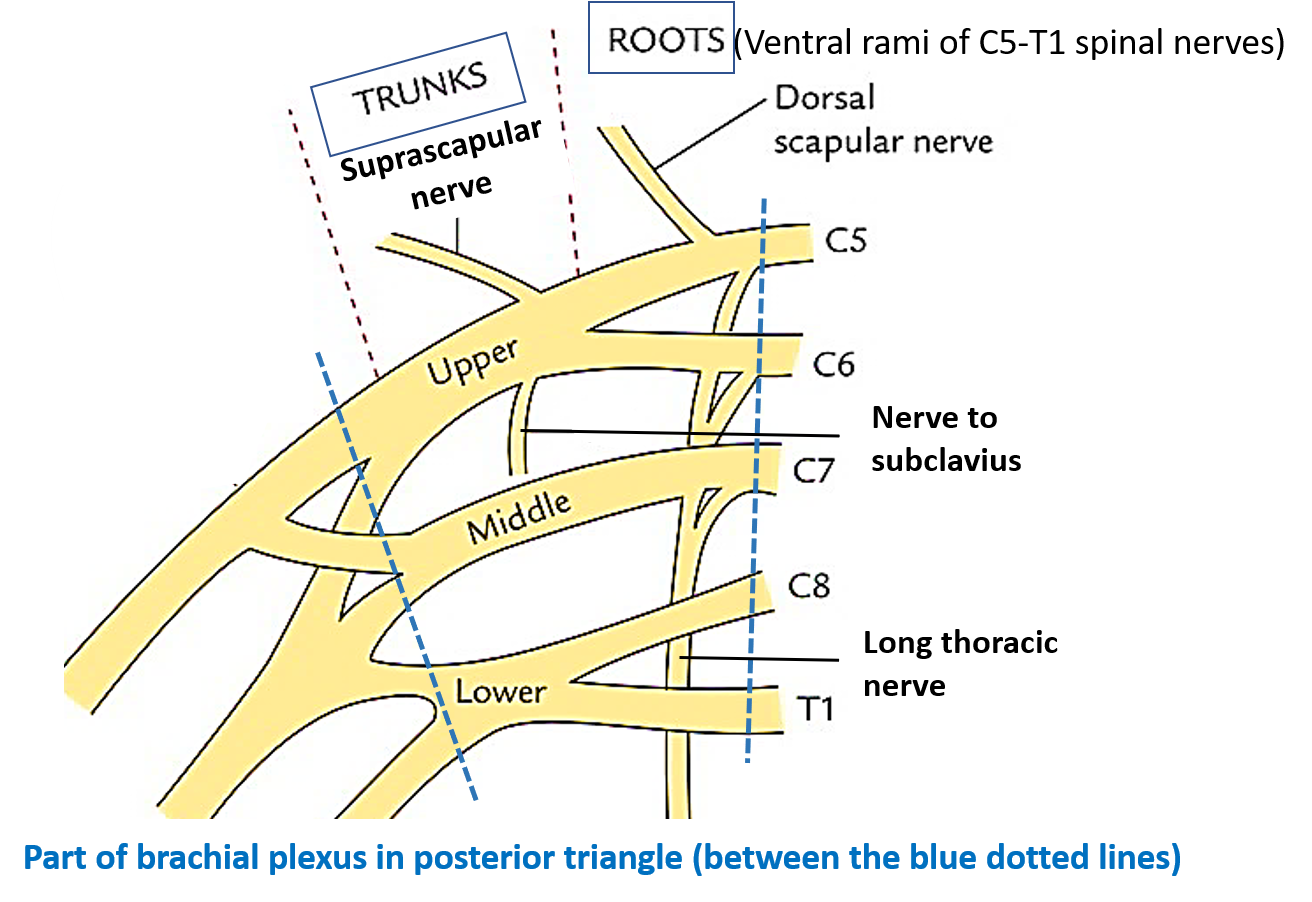
Applied Aspects
Pus in the posterior triangle arising from tubercular cervical vertebra may track downwards in the axilla.
The muscular floor of posterior triangle is covered by prevertebral fascia, which extends around the brachial plexus and axillary artery (continuation of subclavian artery) as axillary sheath. Therefore pus in the posterior triangle deep to prevertebral fascia arising from tubercular cervical vertebra may track downwards and laterally along the axillary sheath to appear in the axilla or even in the arm.
Brachial plexus block
Anaesthetic agent can be injected around the trunks of brachial plexus just above the midpoint of clavicle.
Left Supraclavicular lymph nodes (Virchow’s nodes) may get enlarged in cancer of abdominal organs. What is Troisier’s sign?
Enlarged left supraclvicular nodes can be palpated in the suprclavicular triangle. These nodes are enlarged in cancer of the following abdominal organs as the lymph from these abdominal organs may reach Virchow’s lymph nodes via the thoracic duct which drains into venous system at the junction of left subclavian and left internal jugular vein. Metastasis of cancer cells along the thoracic duct may block drainage leading of thoracic duct leading to regurgitation into the surrounding Virchow’s nodes. The abdominal organs are:
- Stomach
- Colon
- Testis
- Lung
- Mammary gland
Troisier’s sign is an enalrged left-sided supraclavicular lymph node( Virchow’s node).
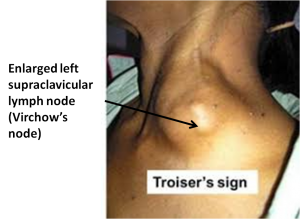
How can bleeding due to laceration of axillary or brachial artery be stopped?
Bleeding due to laceration of axillary or brachial artery can be controlled by compressing the subclavian artery downwards and backwards against the1st rib in the supraclavicular triangle.
Injury to Spinal accessory nerve.
In the posterior triangle the spinal accessory nerve is adherent to the deep aspect of the fascial roof (formed by prevertebral layer of deep cervical fascia) of the triangle and is surrounded by lymph nodes. Therefore, it could be injured in surgery requiring the removal or biopsy of lymph nodes in the posterior triangle of the neck.
Describe origin, insertion, action, nerve supply and relations of Sternocleidomastoid Muscle .
Origin: It takes origin via two heads: sternal and clavicular.
- Sternal head: is a rounded tendon which arises from the anterior surface of superolateral part of manubrium sterni.
- Clavicular head: is flat and musculoaponeurotic and arises from the superior surface of medial 1/3rd of clavicle.
Insertion: It is inserted on the lateral surface of the mastoid process and the lateral half of superior nuchal line.
Action:
When muscle of only one side contracts, it tilts the head towards the shoulder on the same side and rotates the head so that the chin is turned to the opposite side. This movement takes place during an upward sideways glimpse.
When muscles of both sides contract they pull the head forwards as in lifting the head from the pillow or bending the head during eating food. If the head is fixed by prevertebral muscles, it can serve as an accessory muscle of respiration during forced inspiration.
Nerve Supply: It is supplied by the spinal accessory nerve. The proprioceptive fibers are carried by the ventral rami of C2 and C3 spinal nerves.
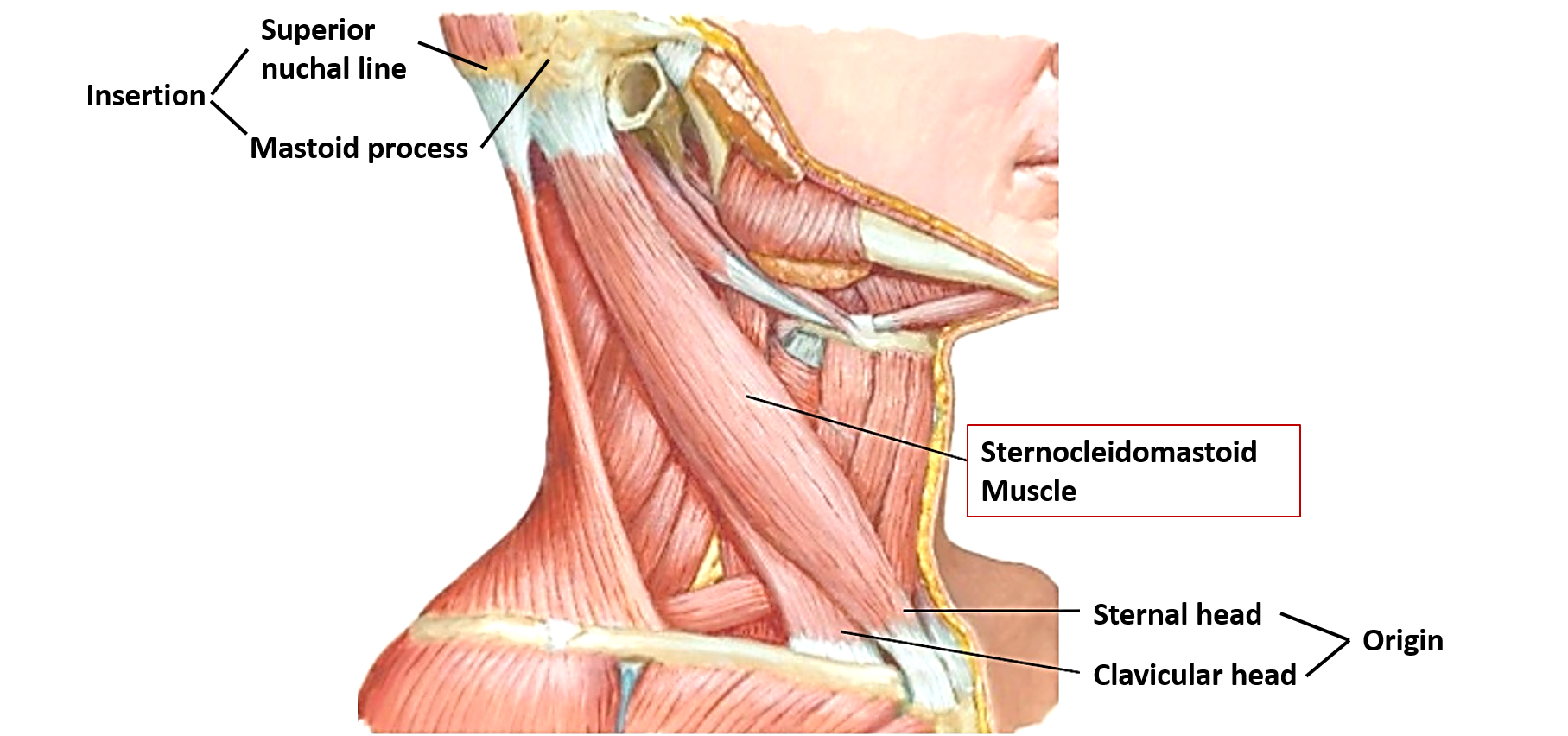
Relations of Sternocleidomastoid Muscle
Superficial relations of sternocleidomastoid muscle:
- Skin.
- Structures in superficial fascia
- 2 cutaneous nerves (great auricular and transverse cervical)
- External jugular vein.
- Superficial cervical lymph nodes.
- Parotid gland
Deep relations of sternocleidomastoid muscle
Upper part:
- Muscle: Posterior belly of digastric and splenius capitis.
- Artery: Occipital artery.
Middle part:
- Muscles: Levator scapulae, scalenus anterior, medius and posterior and inferior belly of omohyoid.
- Arteries: Common carotid and internal carotid.
- Veins: Internal jugular vein.
- Nerves: Vagus, spinal accessory, cervical and upper part of brachial plexus , inferior root of ansa cervicalis.
- Glands: Thyroid gland.
♦ Carotid sheath lies deep to it.
Lower part:
- Muscles: Sternohyoid, sternothyroid and scalenus anterior.
- Arteries: Suprascapular and transverse cervical arteries.
- Nerves: Phrenic nerve.
Applied Aspects
A small triangular gap exists between the two heads of sternocleidomastoid muscle which contains the terminal part of internal jugular vein. A needle or catheter can be inserted into the internal jugular vein at this site.
Torticollis/Wry neck
Torticollis or Wry neck, is a painful twisted and tilted neck. This conditio can be congenital (present at birth) or acquired. Spasm or shortening of sternocleidomastoid muscle of one side results in head bent on the same side and chin directed to opposite side.
- Spasmodic torticollis is generally caused by exposure to cold or maladjustment of pillow during sleep.
- Reflex torticollis occurs because of stimulation of spinal accessory nerve caused by inflamed or suppurating lymph nodes.
- Congenital torticollis is the most common torticollis, which is present at birth. The cause can be birth trauma or intrauterine malposition of baby which may cause of damage or shortening of the sternocleidomastoid muscle.
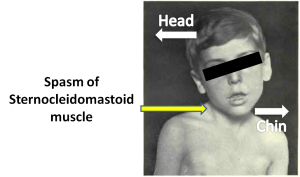

Good